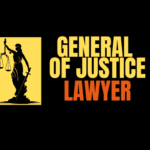
By The General Justice Lawyer, June 9
Los Angeles, California — On June 8, 2025, Los Angeles became a flashpoint of unrest as thousands of protesters took to the streets to oppose aggressive immigration raids by U.S. Immigration and Customs Enforcement (ICE).
The third day of demonstrations escalated into chaos, marked by freeway blockades, arson of Waymo self-driving vehicles, arrests, and the use of tear gas by law enforcement. California Governor Gavin Newsom and Los Angeles Mayor Karen Bass called for calm, but the deployment of National Guard troops deepened tensions.
The protests began peacefully but quickly intensified. By midday, an estimated 1,000 protesters gathered near the Metropolitan Detention Center in downtown Los Angeles, chanting slogans and holding signs against ICE’s mass deportation operations. Demonstrators then spilled onto the 101 Freeway, halting traffic and drawing national attention.
The situation turned destructive when protesters targeted Waymo self-driving taxis. At least five vehicles were vandalized, with tires slashed, windows smashed, and anti-ICE messages spray-painted on their bodies. Three Waymos were set ablaze, sending black smoke into the sky as electric batteries ignited, causing small explosions. Some protesters threw Lime electric scooters into the flames, escalating the vandalism.
Waymo suspended its driverless rides in response.As the crowd grew unruly, the Los Angeles Police Department (LAPD) declared an unlawful assembly, ordering approximately 200 remaining protesters to disperse. When some refused, police deployed less-lethal munitions, including tear gas and smoke canisters, to break up the crowds.
Clashes ensued with both LAPD and 2,000 National Guard troops, deployed by President Trump to support ICE operations. Multiple arrests were made, though exact numbers remain unconfirmed. Small fires and smoke filled downtown streets, creating a tense atmosphere.
The protests were a direct response to ICE’s sweeping immigration raids across Los Angeles, part of a broader crackdown on undocumented immigrants under the Trump administration.
Described as “military-style,” these operations targeted multiple locations, with dozens reportedly taken into custody. Protesters, including activists and community members, decried the raids as inhumane, accusing federal authorities of instilling fear in vulnerable communities.
The deployment of National Guard troops further inflamed tensions. Many saw the militarized response as an overreach, escalating a local issue into a national debate on immigration policy.
Protesters also expressed frustration with the presence of Waymo vehicles, viewing them as symbols of corporate surveillance amid the crackdown, though no official statement linked the vandalism to this sentiment.
Governor Gavin Newsom sharply criticized the vandalism, calling the burning of Waymo vehicles “deranged behavior” that undermined the protesters’ cause. He urged restraint while condemning the federal government’s heavy-handed tactics. Los Angeles Mayor Karen Bass echoed calls for de-escalation, warning protesters not to “play into the administration’s hands” by resorting to violence.
Both leaders faced criticism from Republicans, who accused them of siding with protesters over law enforcement.
President Trump demanded that Newsom and Bass “apologize to the people of Los Angeles” for failing to maintain order, defending the National Guard’s presence as necessary to support ICE. The conflicting responses highlighted a deep divide between local and federal authorities.
By Sunday night, the protests subsided, but Los Angeles remained on edge. The LAPD held a press conference, defending the use of tear gas and less-lethal munitions as necessary to restore order. Mayor Bass announced plans to engage community leaders to prevent further violence, while ICE confirmed that enforcement operations would continue for at least 30 days in L.A. County, raising fears of renewed unrest.
The destruction of Waymo vehicles has sparked a separate debate about public safety and autonomous technology. Waymo’s suspension of services could disrupt local transportation, and the company has yet to announce a timeline for resuming operations. Meanwhile, the National Guard’s presence has raised concerns about the militarization of civil protests, with critics arguing it risks escalating tensions further.

As immigration remains a polarizing issue, Los Angeles could face more demonstrations. California lawmakers are already pushing bills to protect immigrants in schools and hospitals, signaling a broader resistance to federal policies. Whether these efforts can de-escalate tensions or fuel further conflict remains unclear.
The events of June 8, 2025, have left Los Angeles grappling with complex questions about immigration, public safety, and civic expression. The fiery protests, marked by burning Waymos and tear gas, underscore the deep divisions over federal immigration enforcement. As Governor Newsom and Mayor Bass navigate the fallout, the city’s response will shape its future–and the national conversation. Stay tuned for updates as this story develops.
Sources: CBS News, NBC Los Angeles, Los Angeles Times, The Telegraph, Al Jazeera, Yahoo News, WSIU, New York Times, AOL, NBC News, KTLA.
Author

Latest entries
 Donna Adelson Trial2025-09-05Donna Adelson Found Guilty on All Counts in Dan Markel Murder Case
Donna Adelson Trial2025-09-05Donna Adelson Found Guilty on All Counts in Dan Markel Murder Case True Crime2025-09-03Epstein Files: Survivors Break Silence on Capitol Hill
True Crime2025-09-03Epstein Files: Survivors Break Silence on Capitol Hill US2025-09-03Cardi B Assault Trial Verdict — She’s Not The Drama
US2025-09-03Cardi B Assault Trial Verdict — She’s Not The Drama US2025-08-30Jim Crow Era — Louisiana’s Split Juries Problem and the Limits of Retroactivity
US2025-08-30Jim Crow Era — Louisiana’s Split Juries Problem and the Limits of Retroactivity



